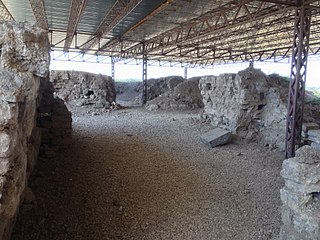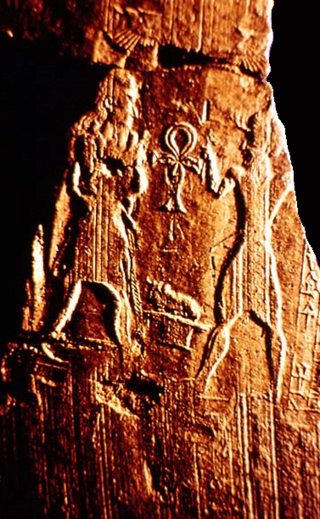
Resheph was a god associated with war and plague, originally worshiped in Ebla in the third millennium BCE. He was one of the main members of the local pantheon, and was worshiped in numerous hypostases, some of which were associated with other nearby settlements, such as Tunip. He was associated with the goddess Adamma, who was his spouse in Eblaite tradition. Eblaites considered him and the Mesopotamian god Nergal to be equivalents, most likely based on their shared role as war deities.

Yamhad was an ancient Semitic-speaking kingdom centered on Ḥalab (Aleppo) in Syria. The kingdom emerged at the end of the 19th century BC and was ruled by the Yamhad dynasty, who counted on both military and diplomacy to expand their realm. From the beginning of its establishment, the kingdom withstood the aggressions of its neighbors Mari, Qatna and the Old Assyrian Empire, and was turned into the most powerful Syrian kingdom of its era through the actions of its king Yarim-Lim I. By the middle of the 18th century BC, most of Syria minus the south came under the authority of Yamhad, either as a direct possession or through vassalage, and for nearly a century and a half, Yamhad dominated northern, northwestern and eastern Syria, and had influence over small kingdoms in Mesopotamia at the borders of Elam. The kingdom was eventually destroyed by the Hittites, then annexed by Mitanni in the 16th century BC.

Ebla was one of the earliest kingdoms in Syria. Its remains constitute a tell located about 55 km (34 mi) southwest of Aleppo near the village of Mardikh. Ebla was an important center throughout the 3rd millennium BC and in the first half of the 2nd millennium BC. Its discovery proved the Levant was a center of ancient, centralized civilization equal to Egypt and Mesopotamia and ruled out the view that the latter two were the only important centers in the Near East during the Early Bronze Age. The first Eblaite kingdom has been described as the first recorded world power.

Qatna was an ancient city located in Homs Governorate, Syria. Its remains constitute a tell situated about 18 km (11 mi) northeast of Homs near the village of al-Mishrifeh. The city was an important center through most of the second millennium BC and in the first half of the first millennium BC. It contained one of the largest royal palaces of Bronze Age Syria and an intact royal tomb that has provided a great amount of archaeological evidence on the funerary habits of that period.

Alalakh is an ancient archaeological site approximately 20 kilometres (12 mi) northeast of Antakya in what is now Turkey's Hatay Province. It flourished, as an urban settlement, in the Middle and Late Bronze Age, c. 2000-1200 BC. The city contained palaces, temples, private houses and fortifications. The remains of Alalakh have formed an extensive mound covering around 22 hectares. In Late Bronze Age, Alalakh was the capital of the local kingdom of Mukiš.

Mari was an ancient Semitic city-state in modern-day Syria. Its remains form a tell 11 kilometers north-west of Abu Kamal on the Euphrates River western bank, some 120 kilometers southeast of Deir ez-Zor. It flourished as a trade center and hegemonic state between 2900 BC and 1759 BC. The city was built in the middle of the Euphrates trade routes between Sumer in the south and the Eblaite kingdom and the Levant in the west.

Ishara (Išḫara) was a goddess originally worshiped in Ebla and other nearby settlements in the north of modern Syria in the third millennium BCE. The origin of her name is disputed, and due to lack of evidence supporting Hurrian or Semitic etymologies it is sometimes assumed it might have originated in a linguistic substrate. In Ebla, she was considered the tutelary goddess of the royal family. An association between her and the city is preserved in a number of later sources from other sites as well. She was also associated with love, and in that role is attested further east in Mesopotamia as well. Multiple sources consider her the goddess of the insitution of marriage, though she could be connected to erotic love as well, as evidenced by incantations. She was also linked to oaths and divination. She was associated with reptiles, especially mythical bašmu and ḫulmiẓẓu, and later on with scorpions as well, though it is not certain how this connection initially developed. In Mesopotamian art from the Kassite and Middle Babylonian periods she was only ever represented through her scorpion symbol rather than in anthropomorphic form. She was usually considered to be an unmarried and childless goddess, and she was associated with various deities in different time periods and locations. In Ebla, the middle Euphrates area and Mesopotamia she was closely connected with Ishtar due to their similar character, though they were not necessarily regarded as identical. In the Ur III period, Mesopotamians associated her with Dagan due to both of them being imported to Ur from the west. She was also linked to Ninkarrak. In Hurrian tradition she developed an association with Allani.

The Early Dynastic period is an archaeological culture in Mesopotamia that is generally dated to c. 2900–2350 BC and was preceded by the Uruk and Jemdet Nasr periods. It saw the development of writing and the formation of the first cities and states. The ED itself was characterized by the existence of multiple city-states: small states with a relatively simple structure that developed and solidified over time. This development ultimately led to the unification of much of Mesopotamia under the rule of Sargon, the first monarch of the Akkadian Empire. Despite this political fragmentation, the ED city-states shared a relatively homogeneous material culture. Sumerian cities such as Uruk, Ur, Lagash, Umma, and Nippur located in Lower Mesopotamia were very powerful and influential. To the north and west stretched states centered on cities such as Kish, Mari, Nagar, and Ebla.

The Royal Palace of Mari was the royal residence of the rulers of the ancient kingdom of Mari in eastern Syria. Situated centrally amidst Palestine, Syria, Babylon, Levant, and other Mesopotamian city-states, Mari acted as the “middle-man” to these larger, powerful kingdoms. Both the size and grand nature of the palace demonstrate the importance of Mari during its long history, though the most intriguing feature of the palace is the nearly 25,000 tablets found within the palace rooms. The royal palace was discovered in 1935, excavated with the rest of the city throughout the 1930s, and is considered one of the most important finds made at Mari. André Parrot led the excavations and was responsible for the discovery of the city and the palace. Thousands of clay tablets were discovered through the efforts of André Bianquis, who provided archaeologists the tools to learn about, and to understand, everyday life at the palace in Mari. The discovery of the tablets also aided in the labeling of various rooms in terms of their purpose and function.

Hotepibre Qemau Siharnedjheritef was an Egyptian pharaoh of the 13th Dynasty during the Second Intermediate Period.
Armi, was an important Bronze Age city-kingdom during the late third millennium BC located in northern Syria, or in southern Anatolia, Turkey, at the region of Cilicia.

The Amorites were an ancient Northwest Semitic-speaking people from the Levant who also occupied large parts of southern Mesopotamia from the 21st century BC to the late 17th century BC. There, they established several prominent city-states in existing locations, such as Isin, Larsa and later notably Babylon and created the Old Babylonian Empire. The term Amurru in Akkadian and Sumerian texts refers to the Amorites, their principal deity and an Amorite kingdom. The term Amorite was never used in contemporary sources before the 1st millennium BC. The Amorites are mentioned in the Bible as inhabitants of Canaan both before and after the conquest of the land under Joshua.

Immeya was a king of Ebla, in modern Syria, reigning around 1750–1725 BCE.

Indilimma, previously read Indilimgur, was likely the last king of Ebla, in modern Syria, reigning around 1600 BCE.
The Early Assyrian period was the earliest stage of Assyrian history, preceding the Old Assyrian period and covering the history of the city of Assur, and its people and culture, prior to the foundation of Assyria as an independent city-state under Puzur-Ashur I c. 2025 BC. Very little material and textual evidence survives from this period. The earliest archaeological evidence at Assur dates to the Early Dynastic Period, c. 2600 BC, but the city may have been founded even earlier since the area had been inhabited for thousands of years prior and other nearby cities, such as Nineveh, are significantly older.

Ishqi-Mari or Ishgi-Mari, previously read Lamgi-Mari, was a King of the second Mariote kingdom who reigned c. 2350-2330 BCE. He is one of three Mari kings known from archaeology, Ikun-Shamash probably being the oldest one. The third king is Iku-Shamagan, also known from an inscribed statue.
Kura was a god worshiped in Ebla in the third millennium BCE. He was the tutelary god of the city, as well as the head of the local pantheon. While his functions are difficult to ascertain, it is well attested that he was connected to the institution of kingship.

Belet Nagar was the tutelary goddess of the ancient Syrian city Nagar. She was also worshiped by the Hurrians and in Mesopotamia. She was connected with kingship, but much about her role in the religions of the ancient Near East remains uncertain.
Barama was a goddess worshiped in the Syrian city of Ebla in the third millennium BCE as the wife of its tutelary god, Kura. She is not attested from any sources postdating the destruction of the city.
Dērītum or Dīrītum was a Mesopotamian goddess associated with Dēr in the kingdom of Mari. While she was originally a hypostasis of Ishtar, she eventually developed into a fully separate deity, and achieved a degree of prominence in the local pantheon during the reign of Zimri-Lim in the 18th century BCE. She is attested in various administrative texts, as well as in personal letters. A celebration focused on her was one of the main festivals in the kingdom of Mari, and participants included both members of the royal family and foreign dignitaries.














